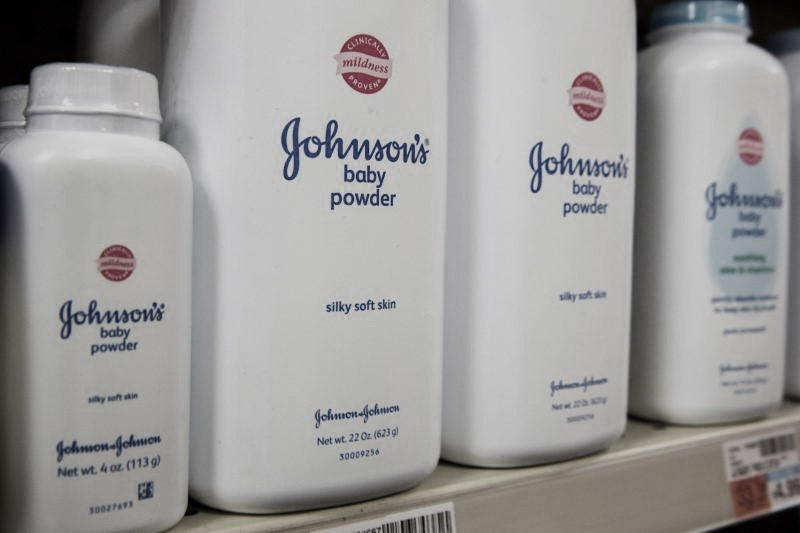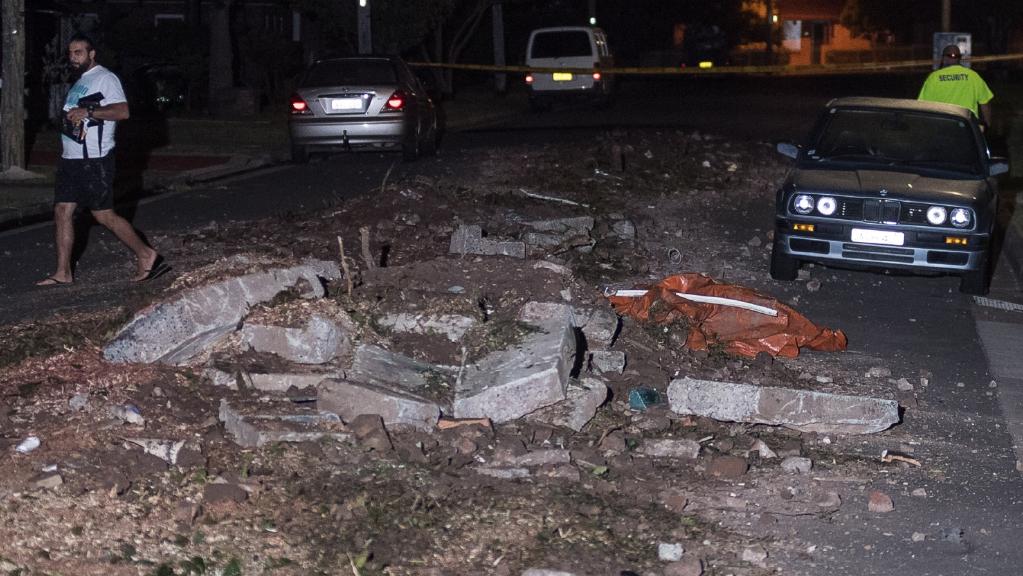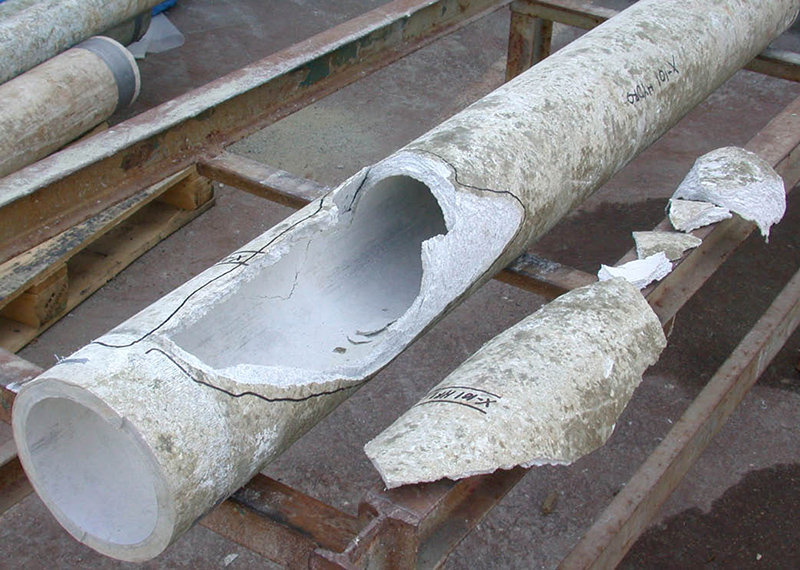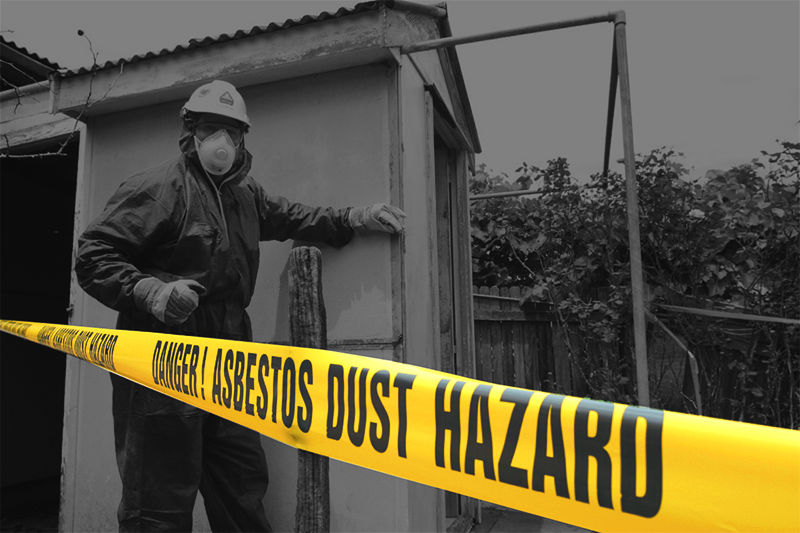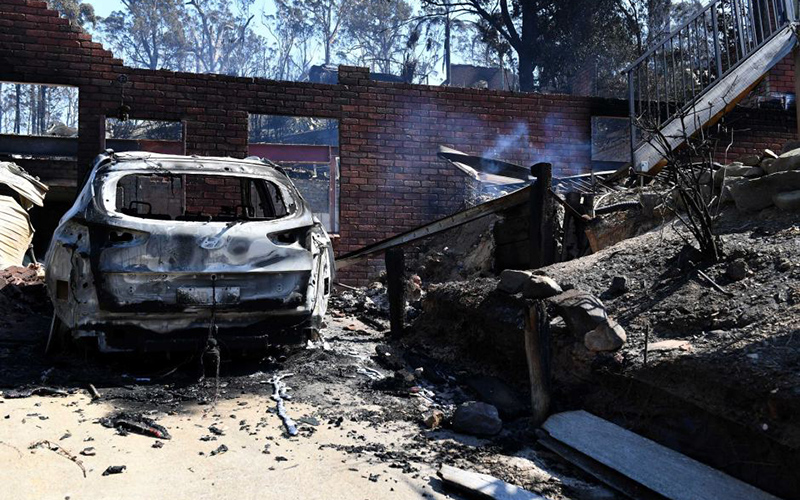If you're planning to use black mastic for tiling or flooring, it's important to take safety measures. Asbestos might be present in it, which can be dangerous if you inhale it. Make sure to follow proper safety guidelines and precautions
Read moreAsbestos Mining Towns: Asbestos, Quebec
In modern Australia asbestos is a word synonymous with danger and disease, but it hasn’t always been this way. There was a time when asbestos was hailed as a miracle material, prized for its incredible heat resistant properties and seen as an important resource.
A hallmark of the western world’s asbestos legacy are the now defunct asbestos towns, places that grew out of, or flourished, due to asbestos mining, but are now mostly forgotten.
The name Asbestos has not aged well...
In this latest instalment we will be looking at the town of Asbestos, in the Canadian province of Quebec
Although it might seem hard to believe, this Canadian town isn’t the only place to take its name from asbestos. In a previous blog post we took a look at Asbest, the Russian word for asbestos and the Russian city home to the world’s biggest functioning open pit asbestos mine.
Previously, this 'honour' - if you can call having the world's largest asbestos mine an honour - belonged to Asbestos' Jeffery mine.
Panoramic view of the Jeffery mine, Asbestos, Quebec
Opened in 1870, the Jeffery Mine - known to locals simply as 'the hole' - gave the town of Asbestos its name and employed a majority of its residents. As is often the case with settlements built around asbestos mines, as the mine flourished so did the town. During this asbestos boom Quebec provided as much as half the entire world's supply of asbestos.
Predictably, the price and demand for asbestos plummeted in the 1980s as the negative health impacts of asbestos exposure became harder and harder to ignore. This lead to the Jeffery mine finally closing its doors in 2011, 8 years after Australia banned asbestos completely.
At the time of the mine's closure the town was home to 7,096 people, 2000 of which worked at the Jeffery mine.
So where is the town of Asbestos now, you ask? Well, in 2012 the town was given a $50 million diversification fund from the Parti Quebecois government, replacing a promise of a $58 million loan to renovate and reopen the mine from the previous government.
Using this grant Asbestos has managed to attract a pharmaceutical company, a duck hatchery and meat processing plant, a cheese factory and a microbrewery. This grant has also helped the town 're-brand' by demolishing all unused mining buildings.
In a somewhat ironic twist, earlier this year it was revealed that Asbestos may be able to strike it rich from asbestos yet again. As it turns out, the tailings left from mining asbestos are rich in magnesium - a useful mineral that can be turned into a metal.
While the town of Asbestos may be changing, one thing that isn't is the name. Despite several attempts to change it, it seems for now anyway, that the town is still stuck with its somewhat unfortunate name.
Related Articles
Johnson And Johnson Looses Asbestos Lawsuit.
A New Jersey court has ordered pharmaceutical and manufacturing giant Johnson & Johnson to pay $37 million in compensatory damages and a further $80 million in punitive damages, to plaintiff Stephen Lanzo III and his wife.
Mr Lanzo claims he developed mesothelioma, a disease caused by inhaled asbestos fibres reaching the lung’s pleural coverings, from using Johnson & Johnson products he used between 1972 to 2003.
The products he says are responsible - Johnson & Johnson’s Shower to Shower and Johnson & Johnson's Baby Powder - both contain talc.
Talc is a naturally occurring grey mineral made of hydrated magnesium silicate that generally forms near or beside asbestos deposits. It is a common ingredient in personal care products like baby powder and make-up and this Johnson & Johnson case is not the first time asbestos has been found in talc used in consumer grade products.
Predictably, Johnson & Johnson have denied claims that their talc based products contain any asbestos fibres, with their lawyer even going as far as to suggest that Mr Lanzo could have been exposed to asbestos through the pipes in his childhood home. However, the jury did not agree with this hypothesis and ruled to award the plaintiff with damages after just one day of the trial.
If Johnson & Johnson’s denial tactics sound oddly familiar, that's because they, unfortunately, are. As we saw in the case of fashion accessory chain Claire’s, which we previously covered, it is common for companies accused of selling products contaminated with asbestos fibres to fiercely deny such claims, even in the face of compelling evidence.
Fortunately, it seems these denial tactics employed by companies like Johnson & Johnson and Claire’s aren’t working long term, with Johnson & Johnson currently facing over 6,600 more lawsuits related to its talc based products.
Make-up products sold by fashion accessory chain Claire's have been found to contain asbestos
In Australia, asbestos has been banned since 2003; however, it is a different story over in the United States, where the Johnson & Johnson case took place.
Troublingly, there are currently no federal regulations in the US that requiring that talc used in consumer grade products, such as baby powder or make-up, is asbestos free and the FDA (Food and Drug Administration) can only take action if there is sound evidence that shows that such products are harmful.
Although, as Australia’s legacy problems with asbestos show, banning asbestos may not be a catch-all solution, it is an essential starting point to an asbestos free future.
Related Articles
The Number Of Mechanics Taking Legal Action For Asbestos Exposure Is On The Rise
Up until the 1980’s asbestos was widely used as a building material in dwellings all across Australia, prized for its insulative and heat resistant properties.
As a result, asbestos can be found in most older homes in locations such as splashbacks, fire places, walls, insulation, piping and underneath tiles. However, one place you might not expect to find asbestos is in the family car.
The amount of mechanics making legal claims for exposure to deadly asbestos is on the rise.
That's right, before asbestos was banned in Australia in 2003 it was not uncommon to find it in car parts such as brakes, clutches, gaskets and hood liners.
Although the use of asbestos in housing products slowed down well before the 2003 ban came into affect, asbestos was still used in car parts into the early 2000’s.
Today, asbestos is usually only found in cars built before the ban (such as vintage and classic cars), with the notable exception of vehicles and parts imported from countries where asbestos is still legal.
Brake pads: Just one of the many places asbestos can be found in older cars.
Sure, it has been illegal to use asbestos in car parts for close to 15 years here in Australia, but unfortunately that hasn't stopped mechanics from being at risk of asbestos related diseases.
According to law firm Slater and Gordon, the number of mechanics requesting legal action for asbestos exposure has increased by 200% in the last two years.
Asbestos exposure is associated with a variety of serious health conditions including mesothelioma, pleural disease, asbestosis and lung cancer. Often it can be difficult to gauge the damage of asbestos exposure as all these aforementioned diseases can take up to four decades to show any symptoms. For this reason we are only now seeing the impact of this latest wave of exposure.
Australia is still facing the consequences of its toxic asbestos legacy.
As Australia continues to grapple with high rates of mesothelioma and ongoing issues with asbestos, it is clearer than ever that the asbestos ban is not enough. We must remain vigilant and committed to removing asbestos from our communities and ensure we do not become desensitised to the serious health risks asbestos exposure can lead to.
Related Articles
Asbestos Found In Make-Up Products
As we've previously discussed on this blog, before the health risks of exposure to asbestos were known (and in many cases even after), the mineral was widely used in everything from building materials to roof insulation to break pads to sand pit filler... and now apparently, even make-up.
A lab in North Carolina, USA, recently found trace amounts of tremolite asbestos in a Claire’s (A chain of accessory stores) make-up product aimed at young girls. Although never used commercially, tremolite asbestos is often found in talc, a key component in many make-up products.
Make up; not the first place you would expect to find asbestos...
The tremolite was discovered when a local mother decided to send a sample of her daughter’s make-up into a local lab to see what was in it. What was meant to be a fun indulgence of curiosity took a dark turn when the results showed asbestos was present in the make-up.
Claire's initially pulled nine of its cosmetic products as a precautionary measure; however, after conducting its own testing with two different labs, Claire’s has released a statement refuting the claim their make-up products ever contained traces of the deadly mineral.
The statement issued by Claire’s said “We are pleased to report that test results received to date from two certified independent labs confirm that the products in question are asbestos free, completely safe and meet all government requirements”
A spokesman for Claire’s also added “Any report that suggests that the products are not safe is totally false”.
Accessory chain-store Claire's was forced to re-call nine make up products after reports came out that they contained traces of tremolite asbestos.
Despite Claire’s claims, the lab that conducted the initial testing that found the asbestos is standing by their results, asserting that asbestos was found in a variety of Claire’s make-up products and questioning the validity of the tests conducted by Claire's.
This isn’t the first time asbestos has been allegedly found in make-up. Mid last year American chain store, Justice, stopped selling its ‘Shine Shimmer Powder’ after an investigation revealed it contained asbestos.
Given that asbestos can lead to serious health problems, the presence of the mineral in make-up products is particularly concerning. Here is hoping this latest incident is the last time the mineral is found in cosmetics products.
Related Articles
Asbestos Contaminated Soil Illegally Dumped In Sydney's West.
Police are on the hunt for the culprit responsible for dumping 8 tonnes of asbestos contaminated materials on a suburban street in Chester Hill.
Residents of the Western Sydney suburb woke up Monday morning to find debris scattered all over the road after being illegally dumped at 1am that morning. The road was soon taped off by police as fire crews in hazmat gear began to sift through and clean up the dumped material, which consisted mostly of asbestos contaminated soil.
Asbestos contaminated waste dumped in the middle of the road in the Sydney suburb of Chester Hill.
Understandably the residents of the affected street were not happy about the illegal dumping, with one commentator going as far as calling the individuals responsible for dumping the material ‘potential murders’.
Sure, the phrasing might be a tad dramatic, but the links between asbestos and fatal health conditions like mesothelioma are well established, meaning that the dumped materials pose a serious health risk to the affected street’s residents.
Although it may not make the headlines, asbestos contaminated soil is sometimes found when undertaking demolition, excavation or construction works.
Most home owners are completely unaware that there could be unwanted asbestos buried underneath their house foundations or below their backyard. This is usually due to illegal and improper disposal of asbestos from past demolition, renovation or building works.
Regardless of how it got there, the result is the same: broken pieces of asbestos sheeting scattered throughout the soil. These pieces of asbestos sheeting are easily identified by the waffle-shaped pattern on their underside.
Asbestos fibre board often features a walfle pattern on its underside.
If asbestos contaminated soil is found on your property there are two main courses of action that can be taken:
- All the contaminated soil can be excavated and disposed off as asbestos contaminated waste. Although straightforward, this solution means that all the soil must be disposed of as asbestos waste, costing roughly $330 to dispose of per tonne.
- If the contamination is mainly surface level, an asbestos removal crew can be brought in to hand-pick the pieces of asbestos from the soil. Although tedious, this ensures less asbestos waste and therefore a lower disposal fee.
Asbestos hiding amongst the soil.
Both of these options require a trained asbestos removal crew and supervisor to undertake and supervise the asbestos removal works as well as a third party certifier to approve that the previously contaminated area is now free of asbestos.
Although alarming, by acting quickly and soliciting a professional asbestos removal company, asbestos contaminated soil can be throughly and safety removed.
Related Articles
Australia and Asbestos: Where Are We Now?
November saw the release of the National Asbestos profile (NAP), a report that collates a huge range of information and research to reflect the impact of asbestos in Australia. The profile includes a broad range of information on existing regulation controlling asbestos, rates of asbestos related diseases in Australia as well as our country's past relationship with this dangerous mineral.
Australian asbestos miners mining blue asbestos in Wittenoom gorge, circa 1950.
Although certainly a dense read, the profile provides an in depth view on our nation's current relationship with asbestos and it is definitely recommended reading for anyone working in the asbestos removal industry.
But if you don't have a spare hour to read it (yep, it's a long slog) then fear not, we have read it so you don't have to! Below we have summarised some of the profile's key insights:
- Hands down, the standout messages of the report was the ongoing harmful effects of Australia's past asbestos use. Although the Australia government instituted a total ban on asbestos in 2003, we still have one of the highest rates of mesothelioma in the world. If nothing else, the Australian experience illustrates that asbestos use can still haunt a nation long after the substance has been banned.
- As the 2003 asbestos ban was not retroactive, many asbestos containing products still exist in the community. Between 2008 and 2014 approximately 400,000 tonnes of asbestos were disposed of. That's 20kg for each person in Australia! As of 2016 an estimated 44% of consumed asbestos remained and we are on track to reduced it to 10% by 2055.
Graph courtesy of the Asbestos Safety and Eradication Agency.
- Overall Australia has good multilevel asbestos management in place, spanning local, state/ territory and federal government. The Australian Government is an international leader in advocating a worldwide ban on asbestos and has pushed for chrysotile asbestos to be included in Annex III of the Rotterdam Convention.
- As previously mentioned, Australia has one of the highest rates of mesothelioma and since 2011 an average of 701 people have been diagnosed with the deadly condition each year. It is predicted that by 2021, 19,400 new cases of mesothelioma will have been diagnosed
- Approximately one in five renovations requires asbestos to be removed. Although some of these asbestos removal jobs are carried out by trained professionals, one third of home renovators remove the asbestos themselves. This puts Australia at risk of a 'third wave' of asbestos exposure.
Asbestos awareness month happens every November and is a reminder to home renovators to look out for asbestos.
- A small number of goods containing asbestos continue to be imported into Australia every year. This is mainly due to some international certifications of 'asbestos free' being unreliable.
Well, there you have it! A brief overview of the relationship between Australia and asbestos in 2017.
Sure, we still have some significant hurdles to overcome, but it looks like a bright, asbestos-free future is in store for our nation as long as we treat asbestos with the caution it deserves.
If you are feeling ambitious you can read the full report here.
Related Articles
Asbestos Mining Towns: Asbest, Russia
Living in Australia, it is all too easy to assume that asbestos is feared and strictly regulated all around the world. Unfortunately, this is far from the reality and countries like China, Cuba and India still rely heavily on asbestos based products for automotive parts, building materials and insulation. Even the US continues to import large amounts of asbestos, importing 705 metric tons in 2016, almost twice the amount imported in 2015.
So, where is all this asbestos coming from?
Although it isn’t the only country that still mines the dangerous mineral, Russia is by far the biggest miner and exporter of Asbestos, supplying roughly 60 to 75 percent of the world’s asbestos.
In Russia, the deadly health risks associated with asbestos are covered up and it is even believed that the Russian mafia is behind a powerful pro-asbestos lobby. In short, the Russian love affair with asbestos is still very much in full swing, and nothing showcases this quite as well as the Russian mining town of Asbest.
The Uralasbest mine is 11 km long, 2.5 km wide and 300m deep!
Like the name suggests, Asbest (which takes its name from the Russian word for asbestos), exists for the sole purpose of mining asbestos. The town is home of the Uralasbest mine - the world’s biggest functioning open-pit asbestos mine which is almost half the size of Manhattan! During its 100 years of operation the mine has shipped well over 384 million tonnes of asbestos all around the world.
To say the town of Asbest embraces asbestos would be somewhat of an understatement. Residents have an almost religious reverence for the stuff, seeing it as the town’s protector. Asbestos is referenced in folklore (such as stories about a girl with fibrous hair made from the mineral), billboards in town proudly proclaim ‘ asbestos is our future’, and it is not uncommon for newly weds to have their photo taken overlooking the huge Uralasbest mine .
It is not uncommon for people to take pictures overlooking the mine.
Where Australians see the use of asbestos as a terrible mistake of the past, the Russians of Asbest view it as a sort of guiding light for the future.
Much like the now closed Australian town of Wittenoom, Asbest would cease to exist without the asbestos mining industry, of the 70,000 people who live there, 49,000 of them are directly or indirectly reliant on the Uralasbest mine for income.
To make matters worse, the company that owns the mine also owns a significant amount of the town’s infrastructure. This means that for most of the town’s residents speaking out against the mine or acknowledging the health risks posed by asbestos isn’t really an option.
As the global demand for asbestos gradually decreases, the future of Asbest looks more and more uncertain. Regardless of what the billboards in the town might say, the wide scale use of Asbestos has no place in the modern world.
Related Articles
Cuban Roofing Crisis
When Hurricane Matthew swept through Cuba’s Guantanamo province late last year, stories about how Cuban companies were making and distributing building materials to help the victims quickly made it into the nation’s news cycle.
Whenever the country is ravaged by a hurricane, one of the most repeatedly broadcast images on Cuban television is that of factories churning out asbestos-cement roofing sheets. Largely an exercise in morale boosting, these images of industrious factory workers working hard to manufacture roofing materials for those in need warms the heart of the nation.
But there’s a slight problem…
As is well known in most of the developed world, asbestos causes a wide variety of health problems if inhaled as it doesn’t dissolve or break down. This is because asbestos particles do not evaporate into air and don’t dissolve in water, meaning they linger around for a long time and are easily carried by wind or water. Drinking water can contain asbestos, especially if water pipes are made out of fibre cement.
Piping made from asbestos fibre cement.
The link between exposure to asbestos and diseases such as lung cancer has been known since 1935. In 1991, the World Bank decided not to finance the manufacture or use of products containing asbestos. This subject shocked the world again in 2001, after the World Trade Centre collapsed, when asbestos dust was released into the air.
By means of a European Union (EU) directive, all of its member states have had to ban the sale or use of any kind of asbestos since 2005, and in 2006, the EU launched a campaign with the bold motto: “Asbestos is deadly serious!”
Inhaling abestos dust can lead to a variety of serious health problems.
The World Health Organisation, international medical institutions and US regulatory authorities have drawn up a list of products that contain asbestos and cause cancer in humans. The use of asbestos has been banned in every developed country for decades now, although asbestos use continues in some developing countries, such as the aforementioned Cuba.
The international ban on asbestos is governed by the Rotterdam Convention (in effect since 2004), signed by over 100 member states, but not without controversy as some countries still mine and produce asbestos.
Fortunately here in Australia, there has been a full ban on asbestos since 2003, and we sincerely hope Cuba, and the rest of the world for that matter, follow suit soon.
Related Articles
The Cost Of Not Removing Friable Asbestos Safely
Canberra based demolition and excavation company, Samarkos Earthmoving, has been fined the sizeable sum of $60,00 dollars for work safety breaches.
The breaches occurred back in 2015 when Samarkos was contracted to demolish a house previously riddled with 'Mr Fluffy', an asbestos based insulation product. The house was located on Darke street, in the ACT suburb of Torrens.
Unlike a lot of other asbestos based building materials, which usually consist of asbestos fibres in cement, Mr fluffy is made of friable asbestos, which has its fibres exposed. This makes Mr Fluffy extremely dangerous, as fibres can easily become airborne. For this reason the removal of Mr fluffy is strictly regulated and the common practice for its removal is to use special vacuuming equipment.
A roof containing Mr fluffy
My Fluffy never saw wide use in most of Australia (it is still found in some Sydney homes and even recently in the Sydney Opera House); however, Canberra has a significant number of homes containing the product, most famously in its now defunct Radburn Estates.
During Samarkos' ill fated demolition an excavator operator proceeded to demolish the property before workers had a chance to spray the house down with water. Although the friable asbestos had been previously removed in accordance with regulation, ACT health and safety laws also required that the house be sprayed with water before demolition to prevent the spread of dust.
Predictably, after the house was first struck by the excavator, a huge cloud of dust rose into the air. If it contained asbestos fibres this dust cloud would have posed a serious health risk to the neighbouring houses, as well as the Samarkos workers on site. Fortunately, no evidence of contamination has been found.
The Darke street property post-demolition
Samarkos plead guilty to the breaches and because the plea was submitted to the Industrial Magistrate early the penalty was reduced from $80,000 to $60,000.
This case and the hefty financial penalty it carried are a timely reminder of the importance of safely and correctly removing asbestos, particularly highly hazardous friable asbestos.
Related Articles
November Is National Asbestos Awareness Month
Today marks the beginning of National Asbestos Awareness Month for 2017. The month long campaign takes place every November and aims to educate Australians on the dangers of asbestos.
Sure, it might seem obvious, but asbestos still poses a huge risk to most Australians. Although asbestos has been banned since 2003, Australians still suffer from one of the highest rates of asbestos related disease in the world and the instance of asbestos related diseases is unfortunately on the rise.
Since home renovators and tradespeople are the most at risk of asbestos exposure, the 2017 campaign has adopted the tagline Renovating? Go Slow! Asbestos it's a No Go.
Although the campaign aims to share a variety of asbestos related safety messages, its key message is that many homes contain asbestos, not just those made from fibro. Asbestos is common in most homes built or renovated as late as 1990, and can be found in a variety of places like under floor coverings, in cement floors, in roofing or even in old dog kennels!
Australian actor and Wolf Creek star, John Jarratt, is the offical face of the campaign for 2017. John is a passionate asbestos safety advocate, being all too familiar with the dangers of asbestos after loosing his close friend, actor Harold Hopkins, in 2011 to mesothelioma caused by exposure to the deadly mineral.
Wolf Creek star, John Jarratt, is the face of the Asbestos Awareness Month for 2017
When asked about his involvement in the campaign he said that 'Having the opportunity to warn people about the dangers [of asbestos] is very personal and important to me. I'm delighted to be on board to support this important message'.
As a business involved with the removal and disposal of asbestos, Ausbestos is a passionate supporter of National Asbestos Awareness Month. We are excited to continue to educate the public about the dangers of asbestos and be involved in its safe removal and disposal.
Asbestos awareness month runs from November 1-30. To find out more or to get involved check out the Asbestos Awareness month website.
Related Articles
Asbestos Mining Towns: Wittenoom, WA
Today, Australians are all too aware of the dangers of asbestos. A ban on the use, manufacture and importing of the substance has been in affect for close to 15 years and strict regulations control its removal and disposal. However, Australia hasn’t always been so savvy when it comes to asbestos and you don’t have to dig too deep into our nation’s past to uncover our now faded enthusiasm for the deadly mineral.
A prime example of this is the former Australian mining town of Wittenoom. Located in the Pilbara region of Western Australia, Wittenoom was once home to a booming asbestos mine, famous for its blue crocidolite asbestos.
Mining operations first began in the region in the 1930’s, although it wasn’t until 1943 that a blue asbestos mine was opened in Wittenoom Gorge. Fuelled by the increased demand for asbestos for gas masks and tanks for the war effort, the mine initially flourished, employing 7,000 men and women during its 26 years of operation. As well as those that worked for the mine, an estimated 13,000 people lived in the town and were in some way dependant on the revenue the mine created.
Although the health dangers of asbestos were somewhat known at this time, they were easy to disregard when it was asbestos putting food on the table and money in pockets. This dilemma, and the plight of Wittenoom in general, was the subject of the 1990 Midnight Oil album, Blue Sky Mine; its titular track featuring the lyrics ‘But if I work all day at the Blue Sky Mine there’ll be food on the table tonight’.
If you lived in Wittenoom, exposure to blue asbestos was inevitable. Piles of asbestos tailings were dumped in gorges and those that weren’t dumped were used in everything from roads, to pipelines, and even in children’s sandpits. It is believed that roughly 2000 former Wittenoom residents and mining workers have already died from asbestos related health problems.
Children playing in a 'sandpit' full of deadly blue asbestos tailings.
For this reason the town began to be scaled down in 1978 with residents being offered money to leave their homes. In 2007 Wittenoom was officially taken off the map and degazetted by the state government. Today it is largely a ghost town, with only three permanent residents who stay on despite government warnings.
Wittenoom remains a foul mark on Australia's history, a costly tragedy that can never be erased. Fortunately, today in Australia the health risks of asbestos are very well known and strict legal framework is in place to prevent its mining and use.
However, this is not the case all over the world, and countries like Russia still mine and use huge amounts of asbestos.
Join us next time when we take a look at another very different asbestos mining town. A town so in love with the substance it is named after it: the town of Asbest in Russia.
Related Articles
Hiding In The Roof: Sydney Man Buys Home Riddled With Loose Fill Asbestos
It’s a home buyer's worst nightmare: you purchase a seemingly normal family home only to find out it is riddled with hazardous loose fill asbestos. This might sound like an unlikely scenario, but across Australia an increasing number of recent homebuyers are finding asbestos in their newly purchased home. As a result, forensic house demolitions are on the rise across the country.
One such unlucky homebuyer is Stuart Reese, who purchased his home at auction just over a year ago.
Everything seemed fine until Stuart decided to renovate and came across dirty old insulation falling from the ceiling. At first he didn’t think much of it, after all dirt and dust are just part of renovating, but a couple of weeks later he realised what he had come across was actually loose fill asbestos.
Stuart Reese got more when he bargained for when he bought a house riddled with loose fill asbestos.
Also known as ‘friable asbestos’ or ‘Mr Fluffy’, loose fill asbestos is the most dangerous and hazardous asbestos building material. Unlike other more contained asbestos products, such as fibre board cement, loose fill asbestos is easily airborne and therefore easily inhaled. Found in ceilings and roof cavities, loose fibres from friable asbestos can move to other parts of the home, especially if the friable asbestos is older and has begun to crumble.
It's called 'loose' fill asbesbtos for a reason!
Loose fill asbestos is fairly uncommon, mainly seeing use in colder parts of the country, such as the outer suburbs of Canberra. But, as Stuart’s case proves, the hazardous insulation product can still be found in Sydney homes built in the 1960’s and 70’s.
If you do find loose fill asbestos in your home unfortunately the only viable option is to remove the asbestos then demolish the property. Simply removing the offending asbestos is not enough as contaminants can linger, so to ensure a safe environment the home must be carefully stripped of asbestos, demolished and then the soil must be tested for asbestos.
It might start in the roof, but loose fill asbestos fibres can easily migrate to other parts of the home.
For Stuart, the process of ensuring his property is asbestos free has only just begun. Although he was able to demolish the asbestos ridden property, he must continue to get the property tested every ten years to ensure no asbestos degradation or contamination has occured.
As always, it is important that any asbestos products are removed by licensed professionals and disposed of in a legal and safe manner.
Related Articles
Asbestos Removal Up 40% Over The Past Five Years
Property development in Sydney is booming, just about every street in Sydney at present has a house or apartment building in a state of demolition, renovation or transformation. Whilst, we could all speculate that popular television programming like Channel Nine's The Block has lead to an increase of property owners trying to improve their living spaces by any means possible, the reality is that land is something that simply is not being manufactured; that is, there's a finite supply - and demand is massive.
Copper pipe filled with asbestos
“Asbestos removal jobs in western Sydney have increased 64 per cent since 2015, while Sydney’s eastern suburbs have experienced a 50 per cent jump, year-on-year,”
As Australia's most desirable city and harbouring about 20% of the nations total population, Sydney has just about maxed out it's urban growth plan. Comparatively, New York with a total of 9000 square kilometres is home to 17 million individuals whilst Sydney has a whopping 12,000 square kilometres for a mere 4 million.
So why exactly are property prices in Sydney the second highest on the planet, second only to that of China?





